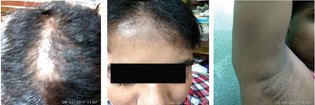A Unique Case of GLPLS in a Male Patient:
- 1. Department of Pharmacology, KPC Medical College, India
Abstract
Graham Little Piccardi Lasseur Syndrome (GLPLS) is a variety of lichen planopilaris rarely seen in male patient. This syndrome presents with cicatricial alopecia of scalp, non-cicatricial alopecia of axillae and pubic region as well askeratotic follicular spinous papules over the body. However, since its 1st reporting by picardi et al., in 1913, such case-reporting and its existence with other variants of lichen planus (LP) has rarely been reported. We analyze and describe this case due to uncommon nature of its presentation.
Keywords
Alopecia, Lichen planopilaris, Oral steroids
Citation
Chatterjee C (2018) A Unique Case of GLPLS in a Male Patient: ‘Old Wine in a New Bottle’. J Dermatolog Clin Res 6(2): 1121.
CASE PRESENTATION
A 28-year-old man presented with patchy loss of the hair on scalp, left eyebrow and axilla associated with hyperkeratotic itchy violaceous plaque on the anterior aspect of left axilla. He refused to talk about hair-loss in the area of pubic region. Some hyperpigmented lesions were also distributed at different parts of the body like lower extremity. He had no history of addiction and drug abuse. On examination of scalp shiny atrophic hair loss in the frontal area was observed. There was also alopecia on the medial aspect of left eyebrow. Examination of axilla showed noncicatricial alopecia with normal skin (Figure 1).

Figure 1 Examination of axilla showed noncicatricial alopecia with normal skin.
Hyperkeratotic violaceous plaque was found on the anterior aspect of left axilla (Figure 2).

Figure 2 Hyperkeratotic violaceous itchy plaques on backside and one side of left axilla.
Routine investigations including viral markers for hepatitis B and C, HIV and serum antinuclear antibody levels were normal. Oral and nail examinations did not reveal any significant finding. Provisional diagnosis of Graham Little Piccardi Lasseur Syndrome (GLPLS) was made. He received methylprednisolone (3 months) for treatment of alopecia almost 12 months back while the problem of hair fall had persisted for last 2 years.
DISCUSSION
Lichen planopilaris is an uncommon follicular variant of lichen planus, inflammatory in nature which causes cicatricial alopecia of scalp. It has three subtypes: classic lichen planopilaris, frontal fibrosing alopecia and Graham-Little-PiccardiLassueursyndrome [1,2].
Graham Little Piccardi Lasseur Syndrome described by Piccardi in 1913, is a rare variant of lichen planopilaris [1]. In addition to the classical triad, a positive pull test for anagen hair can be positive due to altered expression of integrin in active lichen planopilaris lesions [3,4].
Graham Little Piccardi Lasseur Syndrome predominantly affects middle-aged women, though the case itself is very rare [4,5]. But in our case, patient was a 28 years old male. GLPLSis found to be associated with human leukocyte antigen-DR1 seen in familial cases of LP, thus etiologically relating GLPLS to LP [6-8]. In the course of the disease it is estimated that over 50% patients with GLPLS present with at least one episode of cutaneous or mucosal LP. The pathogenetic mechanism of GLPLS involves the upper half of the pilosebaceous unit characterized by lymphohistiocytic infiltration which is the main target of the disease, resulting in destruction of basal stem cells of the bulge region [9].
The extensive and diffuse presentation of GLPLS in this case in addition to concomitant hypertrophic LP affecting the back with no involvement of oral and nail LP depict a rare presentation of LP in a male patient. To the best of our knowledge, this is one of the rarest cases of GLPLS to be reported from Eastern India.
REFERENCES
3. Odom RB, James WD, Berger TG. Andrews’ Diseases of the skin editor. 9th edn. Philadelphia: WB Saunders Company. Lichen planus and related Conditions; 2000. 274-275.
4. Piccardi G. Keratosis spinulosa of the scalp in its relations with the pseudo-pelade of Brocq. ital g of skin and venereal diseases 1914; 49: 416.
7. Tchernev G, Nenoff P. Antigen mimicry followed by epitope spreading: A pathogenetic trigger for the clinical morphology of lichen planus and its transition to Graham Lassueur Piccardi Little Syndrome and keratosis lichenoideschronica-Medical hypotheses or reality? An Bras Dermatol. 2009; 84: 682-688.
8. Daoud MS, Pittelkow MR. Lichen planus. In: Wolff K, Goldsmith LA, Katz SI, Gilchrest BA, Paller AS, Leffell DJ, editors. Fitzpatrick’s Dermatology in General Medicine. 8th edn. New York: McGraw Hill; 2012. 296-311.








































































































































